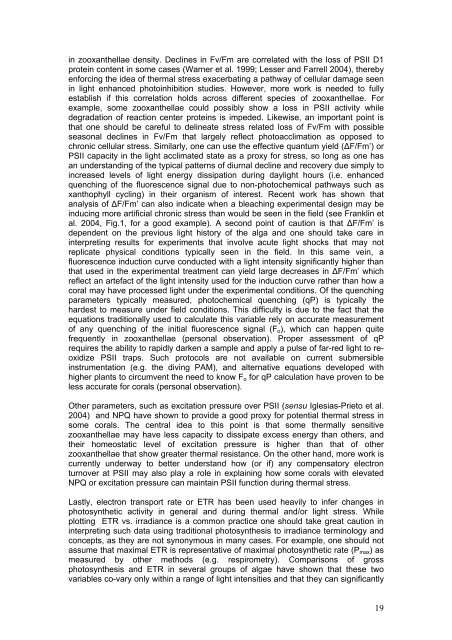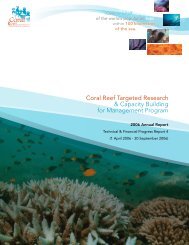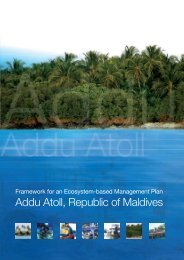Pulse Amplitude Modulation Fluorometry - Coral Reef Targeted ...
Pulse Amplitude Modulation Fluorometry - Coral Reef Targeted ...
Pulse Amplitude Modulation Fluorometry - Coral Reef Targeted ...
You also want an ePaper? Increase the reach of your titles
YUMPU automatically turns print PDFs into web optimized ePapers that Google loves.
in zooxanthellae density. Declines in Fv/Fm are correlated with the loss of PSII D1protein content in some cases (Warner et al. 1999; Lesser and Farrell 2004), therebyenforcing the idea of thermal stress exacerbating a pathway of cellular damage seenin light enhanced photoinhibition studies. However, more work is needed to fullyestablish if this correlation holds across different species of zooxanthellae. Forexample, some zooxanthellae could possibly show a loss in PSII activity whiledegradation of reaction center proteins is impeded. Likewise, an important point isthat one should be careful to delineate stress related loss of Fv/Fm with possibleseasonal declines in Fv/Fm that largely reflect photoacclimation as opposed tochronic cellular stress. Similarly, one can use the effective quantum yield (∆F/Fm’) orPSII capacity in the light acclimated state as a proxy for stress, so long as one hasan understanding of the typical patterns of diurnal decline and recovery due simply toincreased levels of light energy dissipation during daylight hours (i.e. enhancedquenching of the fluorescence signal due to non-photochemical pathways such asxanthophyll cycling) in their organism of interest. Recent work has shown thatanalysis of ∆F/Fm’ can also indicate when a bleaching experimental design may beinducing more artificial chronic stress than would be seen in the field (see Franklin etal. 2004, Fig.1, for a good example). A second point of caution is that ∆F/Fm’ isdependent on the previous light history of the alga and one should take care ininterpreting results for experiments that involve acute light shocks that may notreplicate physical conditions typically seen in the field. In this same vein, afluorescence induction curve conducted with a light intensity significantly higher thanthat used in the experimental treatment can yield large decreases in ∆F/Fm’ whichreflect an artefact of the light intensity used for the induction curve rather than how acoral may have processed light under the experimental conditions. Of the quenchingparameters typically measured, photochemical quenching (qP) is typically thehardest to measure under field conditions. This difficulty is due to the fact that theequations traditionally used to calculate this variable rely on accurate measurementof any quenching of the initial fluorescence signal (F o ), which can happen quitefrequently in zooxanthellae (personal observation). Proper assessment of qPrequires the ability to rapidly darken a sample and apply a pulse of far-red light to reoxidizePSII traps. Such protocols are not available on current submersibleinstrumentation (e.g. the diving PAM), and alternative equations developed withhigher plants to circumvent the need to know F o for qP calculation have proven to beless accurate for corals (personal observation).Other parameters, such as excitation pressure over PSII (sensu Iglesias-Prieto et al.2004) and NPQ have shown to provide a good proxy for potential thermal stress insome corals. The central idea to this point is that some thermally sensitivezooxanthellae may have less capacity to dissipate excess energy than others, andtheir homeostatic level of excitation pressure is higher than that of otherzooxanthellae that show greater thermal resistance. On the other hand, more work iscurrently underway to better understand how (or if) any compensatory electronturnover at PSII may also play a role in explaining how some corals with elevatedNPQ or excitation pressure can maintain PSII function during thermal stress.Lastly, electron transport rate or ETR has been used heavily to infer changes inphotosynthetic activity in general and during thermal and/or light stress. Whileplotting ETR vs. irradiance is a common practice one should take great caution ininterpreting such data using traditional photosynthesis to irradiance terminology andconcepts, as they are not synonymous in many cases. For example, one should notassume that maximal ETR is representative of maximal photosynthetic rate (P max ) asmeasured by other methods (e.g. respirometry). Comparisons of grossphotosynthesis and ETR in several groups of algae have shown that these twovariables co-vary only within a range of light intensities and that they can significantly19








